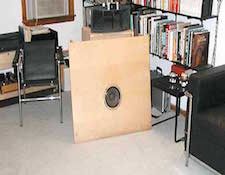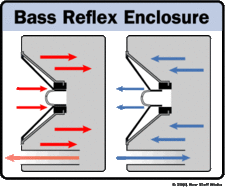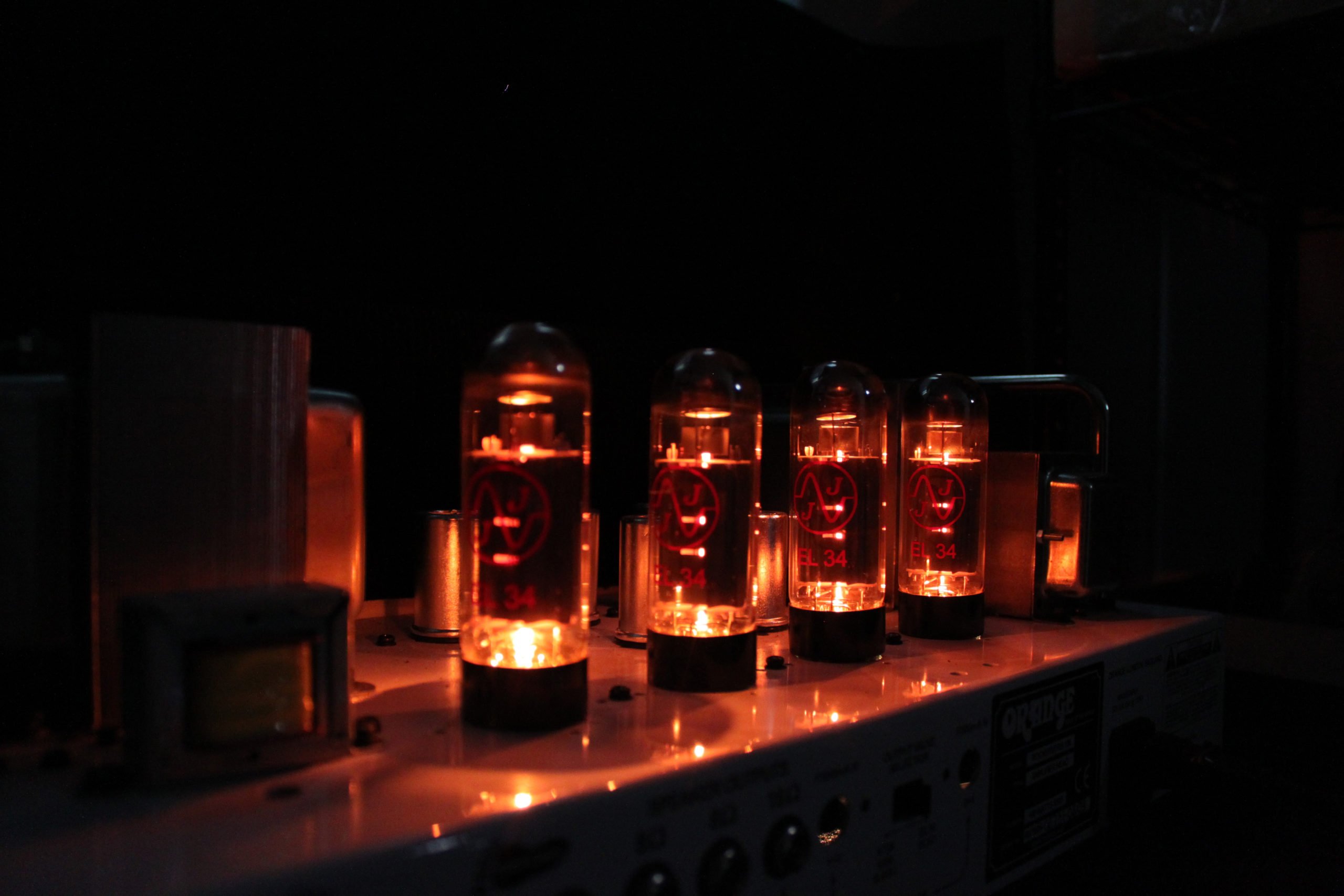It’s the time of year for saving money!
Getting speakers to make good bass is difficult. For one thing, to reproduce the lowest frequencies, it’s generally necessary to use a large cone or other sound-producing diaphragm, but the larger it is, the heavier it usually is, and the more subject to inertia, which keeps it from accurately following the waveform of the signal driving it. For another, if the half wavelength of the lowest frequency to be reproduced is greater than the diameter of the driver producing it, the pressure waves coming off the front and the back of the driver can meet and cancel each other, causing a perceived loss of bass frequencies, even if the driver is quite happily producing them. That’s why, unless you’re using more drivers, special drivers, or special equalization, possibly backed with huge amounts of power, open-baffle or no-baffle construction won’t produce deep bass and, if that’s what you want, it’s why you’re going to have to put your bass driver(s) in/on some kind of enclosure or baffle.
 Certainly the simplest option for that would simply be to mount the driver(s) to a huge board extending some considerable distance in every direction in the plane of the speaker – a so-called “infinite baffle”. That would perform the necessary service of keeping the front and back pressure waves from the driver from ever meeting and canceling, but it would also be way too BIG for any home application. Don’t worry about it, though, instead of keeping the board flat, you can “fold” it to become a sealed box. (Also called an “infinite baffle, and for the same reason)That, too, would keep the waves from meeting and, as long as the internal volume it enclosed was big enough not to create pressure buildups that would raise the effective resonant frequency of the diaphragm or keep it from moving freely, would work just fine and let the driver do its job unimpeded.
Certainly the simplest option for that would simply be to mount the driver(s) to a huge board extending some considerable distance in every direction in the plane of the speaker – a so-called “infinite baffle”. That would perform the necessary service of keeping the front and back pressure waves from the driver from ever meeting and canceling, but it would also be way too BIG for any home application. Don’t worry about it, though, instead of keeping the board flat, you can “fold” it to become a sealed box. (Also called an “infinite baffle, and for the same reason)That, too, would keep the waves from meeting and, as long as the internal volume it enclosed was big enough not to create pressure buildups that would raise the effective resonant frequency of the diaphragm or keep it from moving freely, would work just fine and let the driver do its job unimpeded.
What, though, if the driver needs a little help? The simplest solution there, once you’ve already got your driver in a box, is to make a hole in the box and “tune” the captive volume of air so that, by resonating at the right frequency and having the resonated back-wave come out of the hole (the “port”) IN-PHASE with (instead of canceling) the front wave, it will augment the driver’s effective output at the “tuned” frequency. That’s called a “bass reflex” enclosure, for the simple reason that it applies for bass frequencies, only and because the back wave is “turned around” in a reflex action to support the front.
 Generally, I’ve not had a great deal of enthusiasm for bass reflex enclosures: As you can imagine, unless special efforts are taken (with “distributed port” or other designs, for example), they can only be tuned to a single frequency or a very narrow range of frequencies, and can tend toward single-frequency “boominess” and “one note bass”. Imagine my surprise, therefore, when I first heard Goldmund’s Analogue speakers (little brothers to the famed Apologues) and found myself remarking on their deep, “tight”, and very “quick” bass. It was the same thing more recently with my ACA Seraphims, which use only 6 ½ inch woofers in a tuned-port enclosure, but still go down to some 28 Hz and will genuinely shake the walls!
Generally, I’ve not had a great deal of enthusiasm for bass reflex enclosures: As you can imagine, unless special efforts are taken (with “distributed port” or other designs, for example), they can only be tuned to a single frequency or a very narrow range of frequencies, and can tend toward single-frequency “boominess” and “one note bass”. Imagine my surprise, therefore, when I first heard Goldmund’s Analogue speakers (little brothers to the famed Apologues) and found myself remarking on their deep, “tight”, and very “quick” bass. It was the same thing more recently with my ACA Seraphims, which use only 6 ½ inch woofers in a tuned-port enclosure, but still go down to some 28 Hz and will genuinely shake the walls!
And that gets me, finally, to the subject of this article: some of the preconceptions and misconceptions that seem to run rampant in the audiophile community. We’ve all encountered them; the thing I just cited about bass reflex speakers was one – the belief in advance of the facts that such a speaker design could never give really good results. So, also, are the bases for many, if not most of, the great ongoing controversies in High-End audio. You know the ones I’m talking about: (Take your pick) Tube designs are, by their nature, better than solid state. Or the reverse. Analog is better than digital. Or, again, the reverse. Horns are better (or worse) than other speaker designs. Or the same thing about any other speaker style, type, or mode of construction.
 No matter what you want to say or what you want to say it about, it’s probably possible to point to a glowing (or stinky) example to prove your point. The problem is that, like the Goldmunds or ACAs disproving my preconceptions about bass reflex speaker designs, there are always plenty of other examples to prove the exact opposite.
No matter what you want to say or what you want to say it about, it’s probably possible to point to a glowing (or stinky) example to prove your point. The problem is that, like the Goldmunds or ACAs disproving my preconceptions about bass reflex speaker designs, there are always plenty of other examples to prove the exact opposite.
The fact of it is that, whatever you want to talk about, there’s always more to it than just the one characteristic you’re pointing to: Tube electronics AREN’T just tubes; they’re tubes and capacitors and resistors and transformers and wire and a chassis and — as I was just talking about recently with my pal John Curl — the chassis cover, which, depending on what it’s made out of, CAN affect the sound (Thanks, too, Tony DiChiro), and the genius (or lack of it) of the designer, and the skill (or lack of it) of the person who actually soldered it all together, and even the generosity (or lack of it) of the accountant or executive who set the production budget and approved the purchase of the materials from THIS supplier instead of THAT one.
Now, here’s something that may come as a surprise to you: It’s possible for either tubes or solid state to sound better than the other. It’s also clearly and obviously possible for digital to sound better than analog recordings, or vice versa. Or for any kind of speaker to sound better than any other kind of speaker or even – wait for it… wait for it… for one kind of cable to sound better (or to put it more accurately, to sound WORSE) than another.
It is absolutely reasonable to make judgments based on experience or information. If that weren’t true, we’d all be trapped into giving conscious thought to – in short, judging – every single thing that we ever do, think, or use, every single time that we do, think, or use it. Obviously, that’s not an effective way to live. On the other hand, to generalize completely — to say that all of THIS is good and all of THAT is bad, is to risk being sadly and (especially if it involves the purchase of thousands of dollars’ worth of hi-fi gear) expensively disappointed. Whether or not a thing will be or do for you what you want it to depends on far more than any single factor. In making your hi-fi purchase decisions, just as you would in every other aspect of your life, the thing to do, is to set aside your preconceptions, get the facts, look into all potentially viable options, and then use your own ears and the actual equipment to make your final decision. The results might surprise you.








